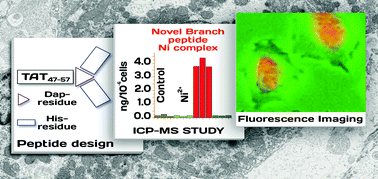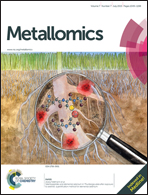A novel branched TAT47–57 peptide for selective Ni2+ introduction into the human fibrosarcoma cell nucleus†
Abstract
A TAT47–57 peptide was modified on the N-terminus by elongation with a 2,3-diaminopropionic acid residue and then by coupling of two histidine residues on its N-atoms. This branched peptide could bind to Ni under physiological conditions as a 1 : 1 complex. We demonstrated that the complex was quantitatively taken up by human fibrosarcoma cells, in contrast to Ni2+ ions. Ni localization (especially at the nuclei) was confirmed by imaging using both scanning X-ray fluorescence microscopy and Newport Green fluorescence. A competitive assay with Newport Green showed that the latter displaced the peptide ligand from the Ni-complex. Ni2+ delivered as a complex with the designed peptide induced substantially more DNA damage than when introduced as a free ion. The availability of such a construct opens up the way to investigate the importance of the nucleus as a target for the cytotoxicity, genotoxicity or carcinogenicity of Ni2+.


 Please wait while we load your content...
Please wait while we load your content...